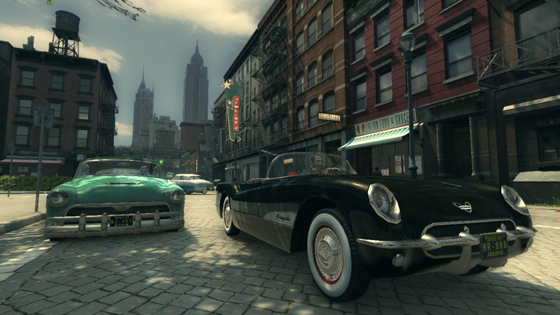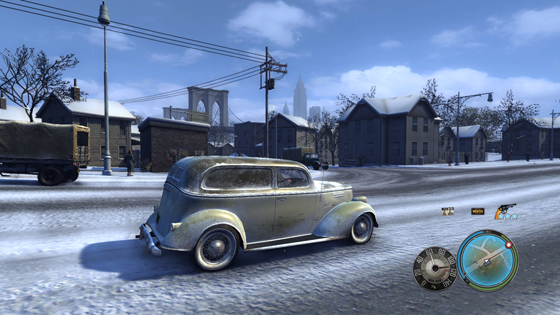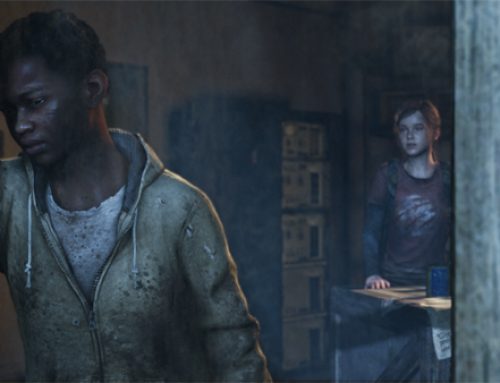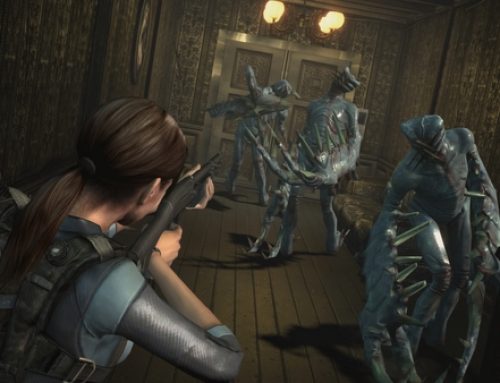Last week, I got a chance to sit down for a little more than three hours to play some “Mafia II,” 2K Games’ M-rated, open-world mobster game that’s due out Aug. 24 for PC, Xbox 360 and PlayStation 3. This was was actually my fourth time playing the game, but it was my first session long enough to really give me a feel for the city of Empire Bay and whether the game’s developers, 2K Czech, succeeded at creating a compelling story filled with interesting characters and surprising twists. I spent the bulk of my playtime on missions related to the core story, so I can’t yet speak to how fun of an open-world playground Empire City is, but I came away pleasantly surprised with the game’s level of polish and attention to detail. What follows is the most detailed impression I’ll be able to give before I play the full game. It’s based off of last week’s session and about a half-hour I spent playing the game during an appointment at E3 last month.
If you’ve missed my earlier previews (here, here and here), “Mafia II” is the story of Vito Scaletta, an Italian-American who goes to Europe to fight Nazis, is wounded in action and returns to Empire Bay, an amalgam of New York and Chicago. His buddy, Joe, pulls some strings to get him out of returning to the front not long before Vito discovers that his father, who died while he was away, left behind some sizable gambling debts. Now, loan sharks are threatening his sister and mom. You can probably see how Vito gets sucked into hooking up with the mob, first as a way to make more money, then (I assume) because once you join, you can never leave. (Cue ominous music.) The game is set during a period that spans the mid-1940s to mid-’50s.

Vito's buddy Joe, right, plays the same role as cousin Roman from "Grand Theft Auto IV." He's your slightly annoying, lovable goof of a buddy who keeps getting you into trouble.
Unsurprisingly, “Mafia II” plays a lot like Rockstar Games’ “Grand Theft Auto” franchise, which shares the same corporate parent. You’ll do plenty of driving around Empire Bay, listening to the radio and taking part in criminal antics ranging from petty crime to assassinations, infiltrations and demolitions. As anyone who’s seen some mobster movies might expect, you’ll be engaging in a lot of shootouts that take advantage of the now de rigueur cover system.
While it’s not anything on par with what you’d find in a top-flight third-person shooter, the cover system is quite well thought out and gives the gunplay segments a little bit of a “stop-and-pop” feel without requiring players to have l33t sniper skillz. During my hands-on time, both last week and at E3, I engaged in shootouts at a slaughterhouse and a distillery, and earlier hands-on opportunities had me trading gunfire in kind of a back-alley area. The weapons handled smoothly, and my success in the shootouts seemed to depend on how willing I was to take a more deliberate approach to things. The couple of times I got impatient and rushed too far ahead, I was quickly killed. For the most part, enemies weren’t overly aggressive or resourceful, meaning you probably won’t find yourself outmaneuvered all that often. But, for the most part, they didn’t seem to be dummies just standing around and waiting for me to pick them off, either. The weapons don’t really jam the way guns from that era often could, but that’s an area where less realism is probably better.
But, as I said, I was more interested in things like story, characters and voice acting this time out. I haven’t really seen anything yet to make me think that “Mafia II’s” broad narrative will deviate much from the standard “criminal rising through the ranks” plot, but that’s not a huge issue as long as there are plenty of surprises along the way.
While the broader story itself has yet to wow me, I was pleased with what I heard from Jack Scalici, director of creative production, who told me about some of the philosophies that guided him while making “Mafia II.” Even though I saw my share of wiseguys in suits, Scalici, an Italian-American native of Brooklyn who knows a mobster when he sees one, says he worked to steer his team made up of Czechs and Americans away from mobster cliches. The use of such genre buzz words as “family,” “respect” and “honor” were largely off-limits to the game’s writers. “When (main character) Vito says ‘family,’ he’s talking about his mom and his sister,” Scalici said. (Mercifully, I didn’t hear a single “fuhgeddaboutit,” either.)
While Scalici was quick to distance himself from mainstream mobster portrayals such as “The Simpsons'” Fat Tony, or any of the “Godfather” movies, he did speak reverentially of “Goodfellas” a couple of times and name-checked “Donnie Brasco,” while acknowledging its later era, so if you’re desperate for a cultural touchstone, those are probably your best bets.
As for the characters, I like that Scalici and Co. didn’t try to romanticize mobsters the way a lot of films and games have. While talking to me, Scalici expressed his desire to emphasize that most low-level mafia thugs ain’t too smart. This played out more than once when we went to execute what seemed a like a perfect plan during a later portion of the game, only to have a minor detail go awry. Before we knew it, one of our buddies was dead, and we were forced to hop into a car and try to chase down in broad daylight a guy we were originally supposed to take out from afar so we could make a quiet exit. Frequently, it seemed like Vito and, by extension, the player were the smartest guys in the room. In other words, as Vito rises through the ranks, it’ll be easy to see why he gets some opportunities that maybe other guys don’t get.
I came away impressed with the game’s attention to detail, and efforts to keep things fresh. One infiltration mission had me sneaking through the sewers. Afterward, a mob boss told me to get myself cleaned up. Before I did so, I bought a health-replenishing hot dog from a street vendor, who commented on the stench emanating from Vito. I’ve played more than a couple of open-world games where the inhabitants react the same way to my character, regardless of whether I’m wearing a road construction cone on my head or am dressed to the nines. Little details such as making an effort to account for changes in the main character’s appearance or smell go a long way toward making a world feel more “real.” (I was slightly disappointed when my stinky Vito, fresh off a shootout at a slaughterhouse where dead people may or may not have been turned into sausages, failed to follow up the hot dog vendor’s quip with a wry comment about his appetite for frankfurters.)
Also helping keep Empire Bay fresh is the fact that “Mafia II’s” story spans multiple decades, as well as multiple seasons. I played snippets from each decade, and experienced Empire Bay in both the summertime and the snow-covered winter.
As a native of the upper Midwest, I was pleased that “winter” was more than just a simple reskinning of the city. Cars driving on snow-covered streets handled noticeably differently than they did during the summertime, adding an element of caution to missions requiring speedy driving. At one point, I rounded a corner too fast while police were pursuing me, slid off the road and found myself driving up a snow-covered embankment. Eventually, my tires got stuck, and I had to try to flee on foot. But there was a hitch: My mission was to deliver the specific car I was driving to a select location. I was foiled by the elements, just like I might be in an actual snowy city.
The transitions from the ’40s to ’50s is also night-and-day, even if it’s slightly exaggerated. (More on that exaggeration in a bit.) Before we journalists got our hands-on time last week, we heard a bit about the transition we’d experience between the two decades. In the 1940s, Scalici emphasized, you couldn’t buy a new car because raw materials and labor were largely going into the war effort. Consequently, the cars in that portion of the game were bulky, drably colored and not a heck of a lot of fun to drive. The music on the radio was stuff like Bing Crosby and Peggy Lee.
In the later, ’50s portion of the game, we got to experience sleek cars with designs inspired by rockets and planes, since many auto factories also produced parts for the aerospace industry. The music on the radio was stuff like Buddy Holly and Danny & The Juniors.
If you’re a stickler for historical accuracy, that last part might drive you nuts. As I sped around in what was clearly denoted as “1951” in the game, I was listening to rock ‘n’ roll tunes from the latter part of the decade. (“Rocket 88,” regarded by some folks as the first rock ‘n’ roll song, was released in 1951. Buddy Holly came later.) During our chat, Scalici said he didn’t want to get too hung up on disqualifying songs from the game based on release date, explaining that he was going for more of a ’50s “feel” than a dogmatic adhesion to a timeline. But don’t most people associate the music of troubled pop producer Phil Spector, which Scalici said will appear in the game, with the 1960s? Spector was born in 1939, meaning he was 11 when the ’50s began.
It’s an issue that seems like it could crop up again and again in the game, which uses Playboy magazines as a collectible despite the fact that Hugh Hefner didn’t even put out the first issue until 1953. As someone who studied history and has fairly extensive knowledge of ’50s and ’60s music for someone my age, I might be more of a stickler for this stuff than most, but I did find myself wondering why, if the game’s cultural touchstones are Playboy, classic cars and the dawn of rock ‘n’ roll, the story wasn’t simply set a few years later. The anachronisms are highly unlikely to ruin the game for me, but they might jar me out of my slack-jawed gaming reverie a few times.
If you’re eager to try the game yourself, a demo is scheduled to hit Xbox Live and the PlayStation Network, as well as the PC, on Aug. 10.





